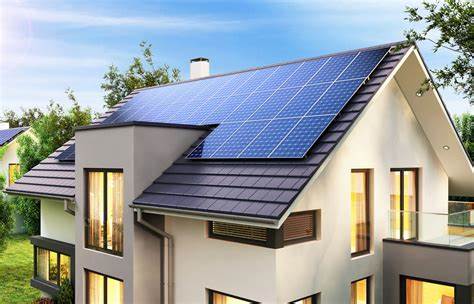Solar is on the Move, and many are excited about the shift from fossil fuel to Solar. Although solar covers a broad area, this blog is about Solar on the roof-tops of residential homes in America. As of 2022, less than 5% of the homes in America have solar panels generating electric power. However, government incentives in the form of tax credits is expected to stimulate growth. In addition, banks and solar installation companies are offering incentives as well. Moreover, manufacturers back their products with solid warranties. Other reasons like Global Climate Change initiatives are part of the reason to change from fossil fuel to this new energy as we experience Solar on the Move.
The race to Solar is Global
One additional point. One year ago my electric bill was approximately $600 for the month. Not unusual if you live in the Phoenix AZ area. One year later at the period where the hot weather is at its hottest, my electric bill, which is mostly due to Air Conditioning, was approximately $90. I’ll leave it there as you read the remainder.
Most believe China is the leader in Solar on the move deployment in the world. The US is second, followed by Japan in third place. And virtually all of the developed countries have goals set with deployment underway. However, only some are convinced and ready to abandon fossil fuels, namely coal, and oil. Some may be misinformed, while others think solar needs a few years to prove its performance. Nevertheless, several facts and arguments motivate the decision to adopt solar as your energy choice. Here are some aditional points:
- Producing a unit of solar electricity cost less than a unit of electricity produced by oil or coal. Thus, solar is more efficient and cost effective.
- Natural gas has become a dominate source of electricity generation due to its relatively low cost and lower emissions compared to coal. Solar in most cases may be slightly higher in cost than natural gas. However, solar technology continues to make improvements in installation costs, cell generation efficiency, as well in performance and cost of batteries.
- Solar reduces the carbon footprint and thus is safer for the environment.
- Having your own solar power plant makes you Energy Independent. You are less dependent on another source for your electricity.
- Government, manufacturing, and financial incentives are available,making the incentives even sweeter.
- Expect an estimated Positive Return On Investment (ROI) in 10 to 15 years.
Cost of Solar vs. other methods to generate Electricity
Estimates are that the cost of a unit of Solar is approximately 33% less than oil and coal. But let’s think about it this way. For the consumer, if you displaced your current electricity source with an appropriately sized Solar System, generating a unit of electricity (regardless of system size) would cost virtually $0. With no intervention from you, th solar cells produce electricity flow from sunlight. And, if your system generates more than needed, it can be stored in batteries for later use, or sold back to the electric company for someone else to use. Look impressive? It’s Solar on the move
Coal, oil and natural gas are not the only forms of electricity generation, there is nuclear and wind as well. Wind, like solar have seen significantly cost reductions, and thus, is one of the most affordable sources of electricity. And, in some cases, wind is more cost effective than solar.Thus, wind and solar are complementary and are often used together to generate electric energy.
Nuclear energy as a source of electricity for sometime now has generated concern for it safety and waste management issues.
Solar has Zero Carbon Emissions.
Estimates are that manufacturing of solar system’s carbon footprint is 20 times less than a coal-powered electricity system. However, solar panels generate Zero Carbon Emissions after manufacture and deployment on the roof.
An Energy-Independent System for Your Home
If your system has an appropriate number of panels and good battery backup, it will survive a power plant outage. The stored energy would be the source of energy during a power plant outage, thus, there would be no need for a gas-powered generator for backup power. Of course improvements in battery storage and cost are needed to make this achievable. However, having a gas-powered generator as a second backup would be a good idea if the entire solar panel system failed and there was insufficient storage.
Government, Manufacturing, and Financial Incentives
The Federal Government is offering a 30% tax credit. That’s 30% of the system’s cost including the cost of installation. And the credit can be applied over five years. In addition, some States are offering an additional $1000 tax credit. Most manufacturers have warranties on the system’s solar panels of 25 to 30 years. That’s awesome, especially if you compare it to the warranty of a new air conditioning system. That warranty is 5 to 10 years. Finally, finance companies provide interest-free, zero payments for one year, with attractive interest rates for the remainder, if not completely paid off in 3 years. Indeed, incentives looks much like Solar on the move.
Positive ROI in 10 to 15 years
System cost will vary by household usage and other factors like roof structure, home energy efficiency, and the electricity drawing appliances. Thus, the average ROI for a household is between 10 to 15 years.
Do the Math
For this example, let’s say the average monthly utility bill for the year is $300.
- At $300 per month, reduced to $0 per month saves $3600 yearly, which is $54,000 saved in 15 years. That saving is more than sufficient to cover the solar system cost. Thus the worst-case ROI is less than 15 years.
- If you use the 30% tax credit, the system cost would effectively reduce to 2/3 of the system cost (including installation). For example, a system costing $50,000 would reduce the price to $33,333. How much tax credit you can use depends on your individual tax and income status. The ROI for $33,333 would reduce to approximately 9.2 years.
- If you account for inflation, the monthly energy cost over time will rise from $300 to $454 monthly. That amounts to an additional savings of approximately $13,000 over 15 years.
- There are many offers of Zero interest and no payments for the first 12 to 18 months.
- Finally, the market value of your home would increase,
From the bullet list above, and only using the first two bullets, 10 to 15 year ROI is the result. If you factor the remaining three bullet items makes 10 to 15 year ROI a conservative estimate. Solar Panels will only work for some. The location of your home, its market value, and its age will determine your system’s price. But you owe it to yourself to take a look.
The next few years will determine the success of the Solar System Movement.
Well, that’s my take on the benefits of Solar Energy. If you have a different opinion or something to add, email me.
Sincerely,
George
There is a growing recognition and need for Protective EMF products and solutions. To learn more about the impact of EMF, and helpful responses to EMF





